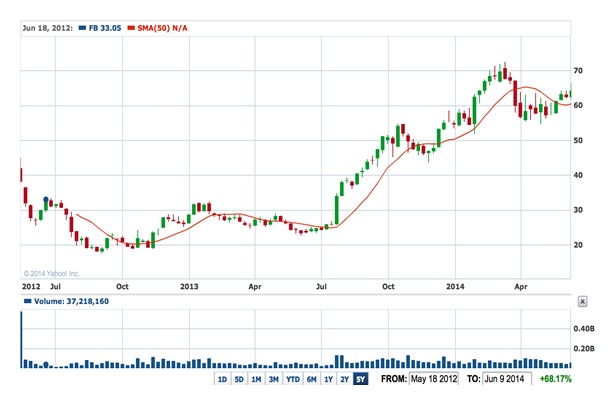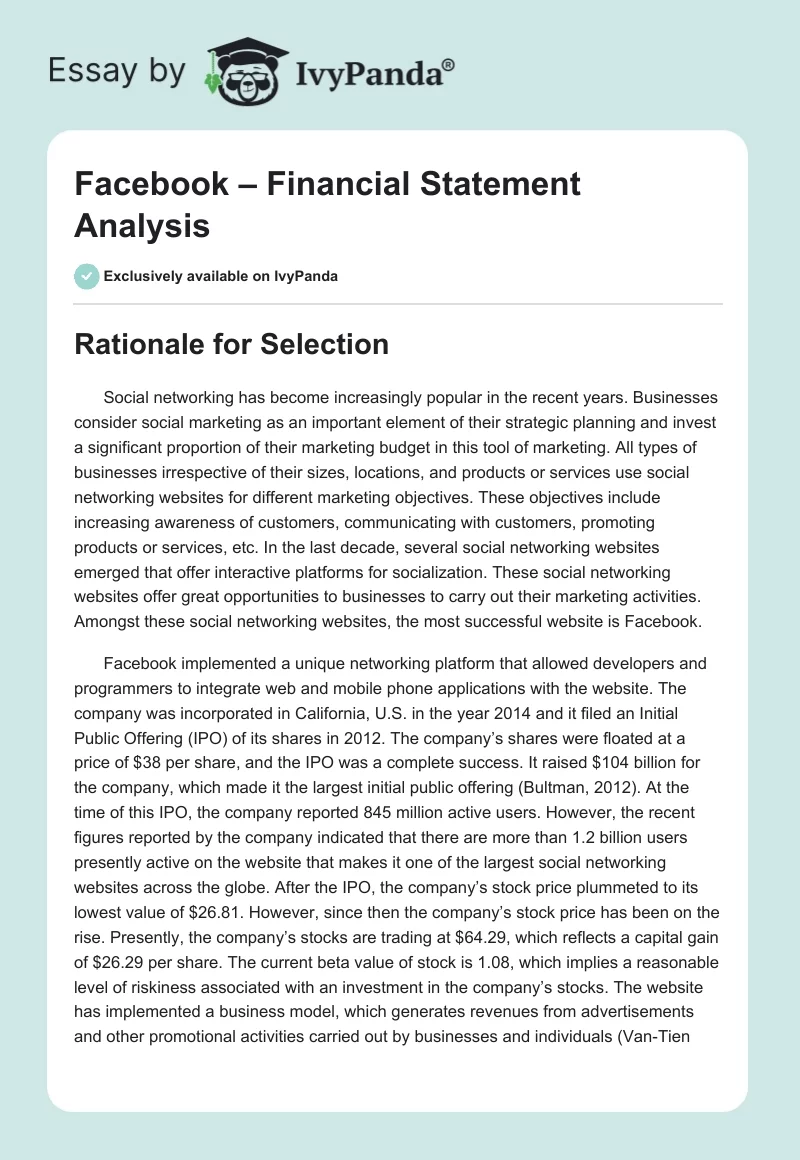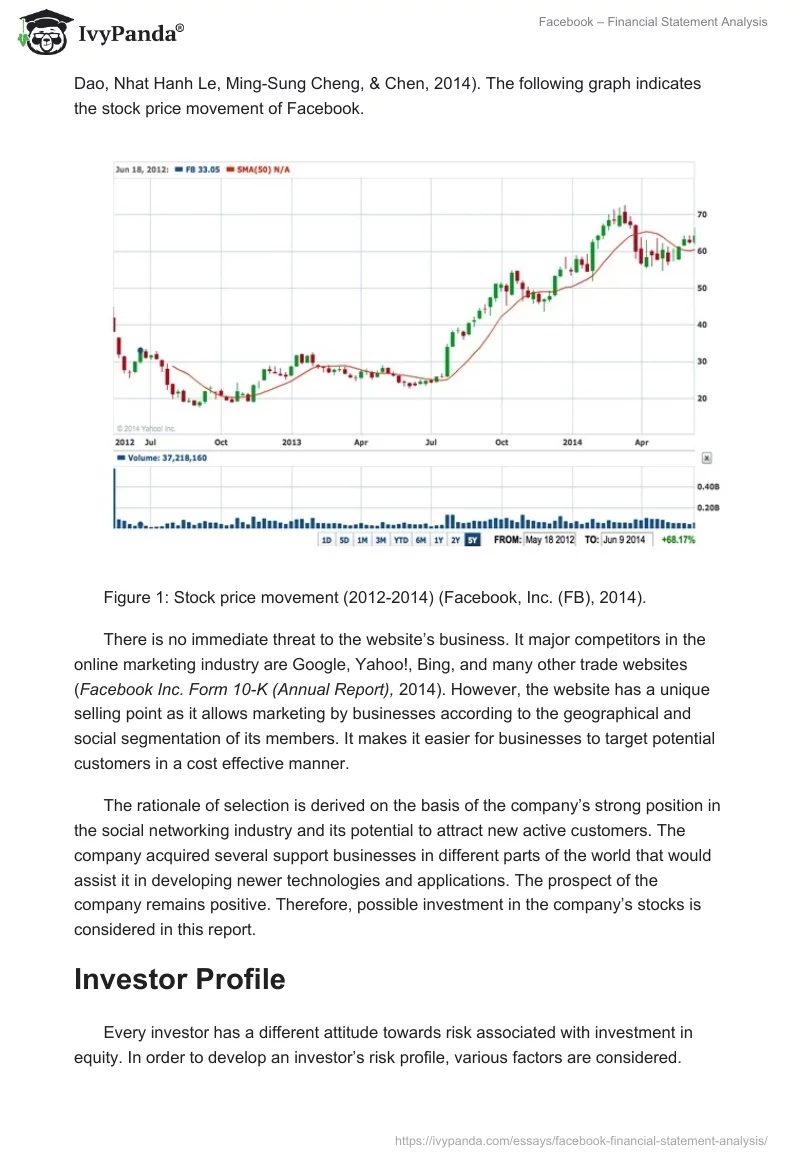Rationale for Selection
Social networking has become increasingly popular in the recent years. Businesses consider social marketing as an important element of their strategic planning and invest a significant proportion of their marketing budget in this tool of marketing. All types of businesses irrespective of their sizes, locations, and products or services use social networking websites for different marketing objectives. These objectives include increasing awareness of customers, communicating with customers, promoting products or services, etc. In the last decade, several social networking websites emerged that offer interactive platforms for socialization. These social networking websites offer great opportunities to businesses to carry out their marketing activities. Amongst these social networking websites, the most successful website is Facebook.
Facebook implemented a unique networking platform that allowed developers and programmers to integrate web and mobile phone applications with the website. The company was incorporated in California, U.S. in the year 2014 and it filed an Initial Public Offering (IPO) of its shares in 2012. The company’s shares were floated at a price of $38 per share, and the IPO was a complete success. It raised $104 billion for the company, which made it the largest initial public offering (Bultman, 2012). At the time of this IPO, the company reported 845 million active users. However, the recent figures reported by the company indicated that there are more than 1.2 billion users presently active on the website that makes it one of the largest social networking websites across the globe. After the IPO, the company’s stock price plummeted to its lowest value of $26.81. However, since then the company’s stock price has been on the rise. Presently, the company’s stocks are trading at $64.29, which reflects a capital gain of $26.29 per share. The current beta value of stock is 1.08, which implies a reasonable level of riskiness associated with an investment in the company’s stocks. The website has implemented a business model, which generates revenues from advertisements and other promotional activities carried out by businesses and individuals (Van-Tien Dao, Nhat Hanh Le, Ming-Sung Cheng, & Chen, 2014). The following graph indicates the stock price movement of Facebook.

There is no immediate threat to the website’s business. It major competitors in the online marketing industry are Google, Yahoo!, Bing, and many other trade websites (Facebook Inc. Form 10-K (Annual Report), 2014). However, the website has a unique selling point as it allows marketing by businesses according to the geographical and social segmentation of its members. It makes it easier for businesses to target potential customers in a cost effective manner.
The rationale of selection is derived on the basis of the company’s strong position in the social networking industry and its potential to attract new active customers. The company acquired several support businesses in different parts of the world that would assist it in developing newer technologies and applications. The prospect of the company remains positive. Therefore, possible investment in the company’s stocks is considered in this report.
Investor Profile
Every investor has a different attitude towards risk associated with investment in equity. In order to develop an investor’s risk profile, various factors are considered. These factors include investment experience, risk tolerance, investment goals and objectives, and liquidity requirements of the investor (Thompson, Williams, & Findlay, 2009). A moderate risk profile is considered for investment in stocks of Facebook. An investor with a moderate risk profile is expected to hold his or her investment for a longer tenure. The risk tolerance of such investors is moderate. Such investor expects fluctuations in the stock price during the holding period. These fluctuations are considered temporary and short-term trading in stocks is avoided. The primary objective of the investment is to achieve capital gains from an increase in the stock price. These capital gains are only realized upon selling of stocks (Thompson, Williams, & Findlay, 2009). Moreover, a moderate risk investor does not expect to receive a regular income in the form of dividends from his or her investment. There is a moderate level of risk associated with investment in the company’s stocks as the current beta value is close to one. Stocks that have a beta value close to one have less volatility and investors could expect fewer fluctuations in the stock price (Brigham & Ehrhardt, 2014).
Financial Ratio Analysis
Facebook is a new public limited company, and it filed its financial statements only for the last three years, which are used in this report for the financial ratio analysis. The company’s year-end is on the last working day of the year. The company is incorporated as per the rules and regulations of the Securities Exchange Commission, US. It reports its financials in US Dollar terms. The analysis includes five important financial ratios including current ratio, asset turnover, total debt to total equity ratio, return on equity, and cash flow ratio (Tabbush et al., 2011). The justification for the selection of financial ratios was the objective to assess the performance of the company under four different categories of analysis including liquidity, efficiency, leverage, profitability, and cash flow ratios.
Table 1: Key Financial Ratios. Figures are in ‘000s. Sources: (Facebook, Inc. (FB), 2014b).
The company’s liquidity position remained very strong in the last three years. The current ratio was calculated by dividing Facebook’s current assets by its current liabilities. The current ratio assists in ascertaining a company’s short-term liquidity position. In the last three years, the current ratio value was well above the benchmark value of 1.00 (Tabbush et al., 2011). It suggested that the company did not face any problems related to its short-term obligations. Short-term obligations of the company included “account payable, current portion of long-term debt, and other current liabilities” (Facebook Inc. Form 10-K (Annual Report), 2014). An analysis of the company’s current assets revealed that the company made significant short-term investments in securities of U.S. government and U.S. government agencies (Facebook Inc. Form 10-K (Annual Report), 2014). These investments were available for sale, and the company’s intention to invest in such securities was to generate income from other sources for the company’s shareholders. The company’s cash position remained strong, which helped the company to invest in developing better technology and performing extensive marketing activities. The company has undertaken several initiatives to collaborate with other companies to increase its coverage and number of users (Facebook Inc. Form 10-K (Annual Report), 2014).
Moreover, the company’s Form 10-K report for the year ending December 31, 2013 indicated that the company managed its current liabilities well. The company reduced its external debt by a significant amount in 2013 that suggested that it generated high profits and cash from its operations. It could also be noted that the company’s retained earnings almost doubled in 2013, which suggested that the company held sufficient earnings for reinvestment in the company or repay its external borrowing (Facebook Inc. Form 10-K (Annual Report), 2014).
The second ratio included in this report is the asset turnover ratio. The asset turnover ratio is an important ratio that ascertains a company’s ability to use its assets efficiently and generate higher sales (Brigham & Ehrhardt, 2014). The results indicated that the company improved its asset utilization in 2013. The ratio value was 0.44 in 2013 that implied that the company generated $0.44 of sales from each $1 invested in the company’s assets. In 2012, the ratio value was just 0.34. The company recorded its investments in fixed assets at their historical costs and financial instruments were recorded at their fair value (Facebook Inc. Form 10-K (Annual Report), 2014). The company recorded a sharp increase in its total assets in 2012, which was due to an increase in investment of $4,846 million in marketable securities (Facebook Inc. Form 10-K (Annual Report), 2014). Overall, it could be suggested that the company’s efficiency measured by the asset turnover ratio remained weak in the last three years. Facebook should strive to generate high sales from its business operations. Tough competition by new emerging social networking websites and specialized websites could challenge the company’s business model and its ability to attract application developers.
The leverage ratio values suggested highly liquid long-term position of the company. The company’s was least dependent on external borrowing. It generated sufficient cash flows from its operating activities. The company’s total cash flow from operating activities increased by 161.91% in 2013. Moreover, the company repaid $1,891 million of its borrowed amount in 2013, which it received in 2012 and 2011 (Facebook Inc. Form 10-K (Annual Report), 2014). To assess the company’s leverage position the total debt to total equity ratio was calculated. The ratio value indicated that the company had $0.16 of debt for each $1 of equity. Similarly, a declining trend in the ratio value was observed since 2011. Overall, it could be suggested that the company had a strong leverage position. It should take advantage of its liquidity and make investment in businesses that could help it improve its technology and reduce resources required by users to access Facebook (Facebook Inc. Form 10-K (Annual Report), 2014).
The profitability position of the company was determined by the return on equity ratio. In 2012, the company’s profits declined significantly due to a sharp increase in its cost of revenues and research and development expenditure. The cost of revenues increased by almost 58% in 2012. Also, research and development expenditure increased by 261% in the same year. It reflected that the company’s strategy to improve its technology that could enhance users’ experience and website accessibility (Facebook Inc. Form 10-K (Annual Report), 2014). In 2013, the return on equity improved 0.27% to 9.64%. The company generated net income of $1,491 million in 2013 as compared to $32 million and $668 million in 2012 and 2011 respectively (Facebook Inc. Form 10-K (Annual Report), 2014). It suggested that the company was able to capitalize higher returns from the investment that it made in the previous years. Furthermore, the company was in a better position to explore further avenues of revenues on its website. It has invested in several support businesses that would eventually contribute to the expected increase in the company’s profits. Higher return on equity ratio value implied that the company’s shareholders could expect better returns on their investments. The findings are also supported by an improvement in the company’s earnings per share (EPS) recorded in 2013. The last EPS reported by the company was $0.62 as compared to $0.02 in 2012 (Facebook Inc. Form 10-K (Annual Report), 2014).
Another important ratio that was included in this report is the cash flow ratio. The cash flow ratio assists in determining whether a company is able to generate enough cash flows from its operating activities that could cover obligations of its current liabilities (Ibarra, 2009). It is calculated by “dividing operating cash flows by current liabilities of the company” (Black & Al-Kilani, 2013). It is an important measure of financial performance as it does not use the company’s profits, which could easily be manipulated, to ascertain the company’s ability to settle its debt and trade related obligations (Brigham & Ehrhardt, 2014). The cash flow ratio value improved significantly in 2013 i.e. from 1.53 in 2012 to 3.84. It implied that the company was able to generate higher cash flows from its business operations, which were almost four times its current liabilities. In 2013, the company’s cash flows from operations increased by $2.610 million (Facebook Inc. Form 10-K (Annual Report), 2014). On Even after paying all its current liabilities, the company would have sufficient cash to pay off its long-term liabilities. It could be anticipated that the company would face minimal problems related to its short-term liabilities and trade obligations.
Risk Assessment
Based on the financial ratio analysis of Facebook, Inc., it could be suggested that there were no immediate threats facing the company except certain litigation related to intellectual property claims. The company’s had a strong liquidity position. The strong liquidity position of the company reflected that it would face no problems in the short term. It suggested that a low level of risk is associated with investment in the company. Moreover, the company had low asset utilization. It implied that the company was not making efficient use of its assets to generate the desirable level of revenues. Such situation faced by the company could lead to problems for the company in the future. It also implied that there are risks associated with investment in the company’s stocks. However, if the company further improves its technology and expands its global network then this risk could be mitigated.
The company managed to maintain a low level of total debt in comparison to its total equity. The company proved that it could reduce its dependency on the external debt by generating high cash flows from operations. It also suggested that if the company would require additional capital in the future then it would face fewer difficulties. The expected interest costs would also be lower, as well. The leverage position of the company suggested that there is a low level of risk associated with investment in the company’s stocks.
The profitability of the company fluctuated in the last three years. However, it is understood that profits of any business tend to fluctuate with changes in business and market conditions. Moreover, it was noted that a sharp decline in the company’s profits in 2012 was mainly due to the significant amount of research and development expenditure made by the company to improve its technology and users’ experience. The company generated healthy profits in 2013, and such profits could also be expected from the company’s business in the coming years. The risk level associated with the company’s profits is low.
A better indicator of financial performance was included in this report i.e. the cash flow ratio. The company generated strong cash flows from its operating activities in the last three years. The ratio values indicated that there were no immediate risks faced by the company. It could be suggested that there is a low level of risk associated with the company’s ability to generate cash flows from operations.
The following table summarizes the risk profile of the company, which is evaluated on the basis of the company’s financial performance recorded in the last three years.
The overall risk level associated with investment in the company’s stocks remains low. It is perceived that investments with low risks are expected to generate low returns for investors. In the case of Facebook, an investor could also expect slow and steady growth in the value of its stocks (Baker, Bradley, & Taliaferro, 2014). For a moderate investor, it could favor long term holding of the company’s stocks (Kumar, 2009). An investment in the company’s stocks could generate capital gains in the long term. Moreover, a moderate investor could invest in other similar stocks to reduce the risk level associated with low asset utilization.
Recommendations
In the recent years, technology-oriented companies have outperformed other businesses in terms of their ability to generate profits. However, it was also noted that such companies often failed to maintain their competitive edge and fell behind other companies that introduced new and better technologies (Heinrichs, Lim, & Lim, 2011). Therefore, a cautious approach has to be maintained when making investment in these companies. Since 2004 Facebook proved its ability to outperform other social networking websites, and it continued to improve its technology that not only attracted billions of active users to use its website, but also made the company’s position impeccable in the IT industry. Other companies such as Google and Microsoft on various occasions tried to challenge Facebook’s position in the social networking industry, but they failed (Curran, Morrison, & Mc Cauley, 2012).
The financial analysis of the company clearly reflected that the company is less likely to face any major risks or threats from other websites. However, it must not stop its innovative process. It should introduce new ways of attracting users in non-English countries such as China where Chinese websites have the major share of social networking market. Moreover, the company should simplify its marketing tools and packages offered to businesses and individuals. For a moderate investor, investment in the company’s stocks is favorable as they offer long-term capital gains.
References
Baker, M., Bradley, B., & Taliaferro, R. (2014). The low-risk anomaly: A Decomposition into micro and macro effects. Financial Analysts Journal, 70 (2), 43-58.
Black, G., & Al-Kilani, M. (2013). Accounting and finance for business. London: Pearson Education.
Brigham, E. F., & Ehrhardt, M. C. (2014). Financial management: Theory and practice (14th ed.). Mason: Cengage Learning.
Bultman, M. (2012). Facebook IPO to make Dobbs Ferry’s Mark Zuckerberg a $24 billion man. Web.
Curran, K., Morrison, S., & Mc Cauley, S. (2012). Google+ vs Facebook: The comparison. Telkomnika, 10 (2), 379-388.
Facebook, Inc. (FB). (2014a). Web.
Facebook, Inc. (FB). (2014b). Web.
Facebook Inc. Form 10-K (Annual Report). (2014). Web.
Heinrichs, J.H., Lim, J.S., & Lim, K.S. (2011). Influence of social networking site and user access method on social media evaluation. Journal of Consumer Behaviour, 10 (6), 347-355.
Ibarra, V. C. (2009). Cash flow ratios: Tools for financial analysis. Journal of International Business Research , 8, 91-107.
Kumar, A. (2009). Who Gambles in the stock market? Journal of Finance, 64 (4), 1889-1933.
Tabbush, V. C., Trueman, B., Levine, D., Opler, T., Brandwein, & Cohen, A. (2011). MBA primer: Finance 3.0 instructor-led printed access card (3rd ed.). Mason, OH: Cengage Learning.
Thompson, James R., Williams, Edward E., & Findlay, M. Chapman (2009). Models for Investors in real world markets. New York: John Wiley & Sons.
Van-Tien Dao, W., Nhat Hanh Le, A., Ming-Sung Cheng, J., & Chen, D. C. (2014). Social media advertising value. International Journal of Advertising, 33 (2), 271-294.


